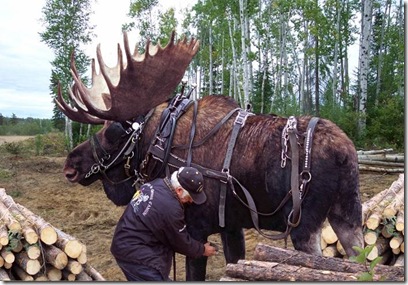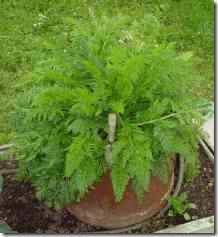Only in Alaska ……. This guy raised an abandoned moose calf with his horses, and believe it or not, he has trained it for lumber removal and other hauling tasks. Given the 2,000 pounds of robust muscle, and the splayed, grippy hooves, he claims it is the best work animal he has. He says the secret to keeping the moose around is a sweet salt lick, although, during the rut he disappears for a couple of weeks, but always comes back home…..
Impressive !!
ALASKAN CLYDESDALE
Bound to be someone out there that will raise some issues with this treatment of a wild animal. To them I say. “If the Moose keeps coming back, what’s the problem?”
February 25, 2009
Only in Alaska – Humor
Posted by Wendy Zake under alaska, Animals, Community, humor, Wasilla | Tags: alaska, Community, humor, Mat-Su, Sutton, Tourism, Travel |Leave a Comment
February 16, 2009
Mat Su Gardening – The World’s Largest Carrot
Posted by Wendy Zake under alaska, Events, gardening, humor, Travel, world records | Tags: alaska, gardening, humor, Mat-Su, photos |Leave a Comment
Heaviest Carrot (longest click here)
According to the Guinness Book of Records John Evans created the World Record heaviest carrot, a whopping 18.985 pounds (8.61 kg) in 1998, a world record for a single root mass.
John V. R. Evans, a mechanical designer who lives 40 miles north of Anchorage in Palmer, Alaska holds seven world records for Giant Vegetables.
John was born in Dungarvan, Ireland was raised in Brecon, South Wales coming from a line of expert horticulturists.
In the 40 years of gardening experience, he has accumulated a great wealth of knowledge from different climactic and soil conditions in 6 countries and 4 U.S. states. He also does extensive research in the chemical, physical and biological properties of his garden and experiments on different plants of the 60 to 70 vegetables seed varieties he grows each year.
In the seven years of competition at the Alaska State Fair he and his wife Mary have accumulated over 180 first places in both quality and giant vegetable categories, with 18 State and 7 World Records.
Can you imagine what it would be like to dig up a carrot from your garden and not knowing how big it is until the last minute, and then finding out that it’s 19 lbs. Now that’s exciting!
John says “Over the years, I have developed my own fertilizers, bio-catalysts, and growing techniques and it would take a whole book to explain.” His advice is that Carrots require a long growing season and should be started in February. Transplant in a high raised bed that has been dug very deeply and enriched with compost and sand. It is really that simple!
But there have been missteps along the way, he notes. First, there are the battles with moose. He and his wife have had to bang on pots and cans in the middle of the night to distract the hungry garden predators.
Even Mother Nature can even be an enemy. In his early days, Evans was walking the cabbage rows at sunrise. All around, there was a strange sound of rubbery stretching as cabbage leaves creaked open. Suddenly, with the sun nestled just above the horizon, the cabbages started exploding. “There was coleslaw everywhere,” he says, laughing. “They had warmed up too quickly on the outside and were still cold on the inside and they just popped open.” Now he knows to stretch wet sacks across the heads to insulate them at night and let them wake up slowly and well-hydrated.
For a world record holder seven times over, John Evans is really a humble sort of chap. In fact, as he tells it in his cheery Welsh accent, he really just sort of fell into the sport. “I came up with the idea to grow large vegetables to promote organic gardening. I don’t use chemicals, fertilizers or any such things. And the plants, they simply love it.”
John doles out a what he calls a “compost tea with nutrients,” a treat that feeds soil bacteria and fungi, which in turn feeds the worms, which in turn fertilize and aerate the soil, which in turn delights the veggies. If it sounds pretty simple, it is at least in theory.
But then there are the man-hours to account for. Though John only gives his crop of cabbages, Swiss chard, carrots, potatoes and zucchini a serving of “tea” once a week, the rest of the time he tends to daily garden duties like any good green fingered gardener.
John’s extra care
The garden covers only a half-acre, and he is up and out there by 4 a.m. every morning, pinching and adjusting and watering the plants. And since he’s in Palmer, Alaska, sitting in the Mantanuska Valley, overlooking a nearby glacier, there are some special measures he has to take. For instance, since the ground might not thaw by the time his growing season rolls around, Evans uses raised beds, which warm up faster. And too, since his well water is often just 38 degrees F, even at the height of summer, he heats it so as not to put the plants into shock.
John’s attention to detail has made him one of the most successful giant gardeners in the field. He says that because he feeds the soil, not the individual plant, his practices tend to yield a giant cornucopia rather than a single specialty. His Guinness World Records suggest that there may be some truth to that. His prize-winners include: a 35-pound broccoli; a 19-pound carrot; a 39.5-pound kohlrabi; a 45-pound red cabbage; a 42.8-pound garden beet; a 28-pound kale; and a 49.1-pound celery. John very modestly says “I just manipulate plants, growing great plants from ordinary seeds. And really, I don’t want to come off like a huge environmentalist. I just am saddened by how few people garden in this country. I learned from my grandmother and my 88-year-old father still acts like a 10-year-old in a candy store when he gets a batch of my soil amendments. It’s really fun, and it’s so good for us to try and be self-sustaining.”
To finish off John is not out to be the World Record holder for ever. He just want to show what can be done with a little effort and no chemicals. “Any layperson in any climate can grow giant vegetables with my methods. And that’s OK. I’ve already made my point.”
You can contact John at: ALASKA GIANT SEEDS, P.O. Box 1072, Palmer, AK 99645, U.S.A., fax +1-907-746-4781, Home Phone +1-907-746-4781, e-mail








